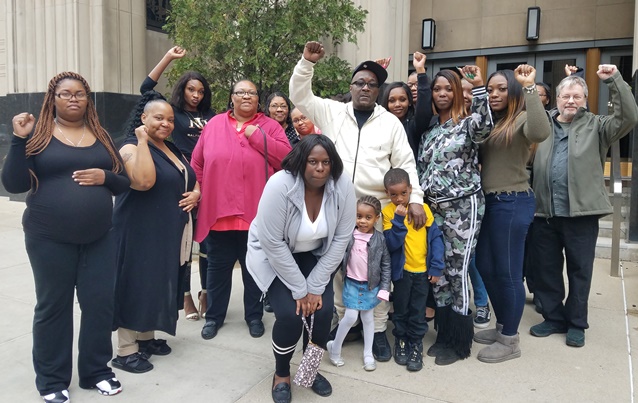
Terrance Kellom’s family and friends outside federal courthouse in Detroit May 2. They include Yvette Johnson (2nd from left), Nelda Kellom, Terrance’s mother (in pink), Kevin Kellom, Terrance’s father, with his son’s two children Terranae Destiny and Terrance Desmond, and group of Terrance’s sisters.

Hammer DPD claimed Terrance had, no fingerprints found
Fed. court hearing May 2 follows DPD off. Darrel Fitzgerald’s admission that Terrance had no hammer, none was in house; did not resist arrest
“He (Fitzgerald) had a tear in his eye during deposition, likely thinking of his own 20-year son”–Atty. Ayad in brief
Forensic evidence negates police version of killing, indicates more than one shooter: shell casings of different kinds found in rear bedroom, bathroom
Terrance Kellom shot in back twice, evidence and eyewitness reports indicated Off. Quinn shot him as he lay on ground
Father Kevin: police saw his son with him in the street before illegally raiding home; they could have arrested him on street.
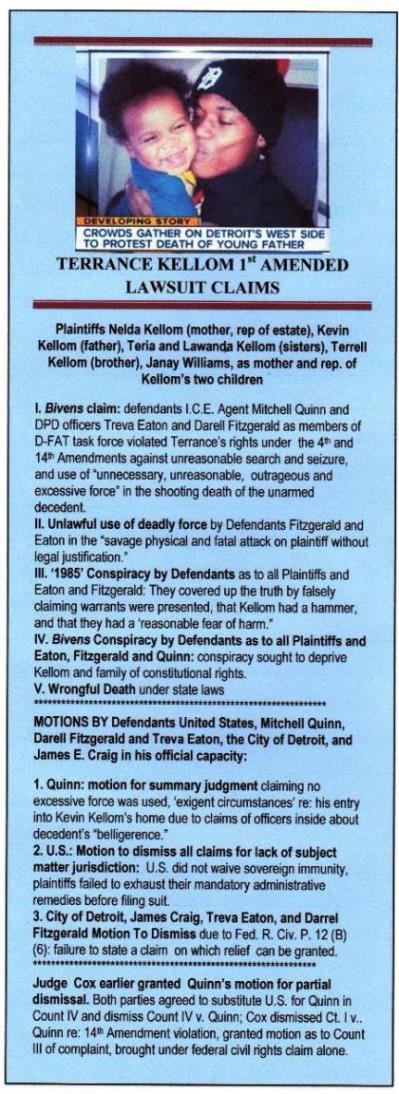 Federal court hearings continue as State AG Dana Nessel, Wayne Co. Pros.Kym Worthy open new investigations
Federal court hearings continue as State AG Dana Nessel, Wayne Co. Pros.Kym Worthy open new investigations
Ayad: “If Kym Worthy doesn’t do her job this time, we will do it for her.”
By Diane Bukowski
May 10, 2019/Updated May 13, 2019
DETROIT – Family and friends of Terrance Kellom, including his two little children Terrance Desmond and Terranae Destiny, packed the courtroom of U.S. District Court Judge Sean Cox May 2 to listen to oral arguments on defense motions to dismiss the family’s civil lawsuit filed after the young father’s death.
The family had watched in agony April 27, 2015 as members of a Detroit Fugitive Apprehension Task Force (D-FAT) including I.C.E., the DPD, and other out-county agencies, shot Kellom a total of four times inside his father Kevin Kellom’s home on Detroit’s near northwest side. Evidence shows I.C.E. agent Mitchell Quinn shot him in back as he lay on the ground.
An additional fusillade of other bullets left spent casings scattered through the home.
Kellom was 19 years old, with a pending arrest warrant for armed robbery. He was also expecting the imminent birth of his second child. and was planning to turn his life around, according to his father.
After the court hearing May 2, family and friends gathered outside and chanted, “Justice for Terrance,” echoing the cry raised in massive street protests, largely by Black youth, that took place directly after Kellom’s death.
Judge Cox held the hearing in the wake of the stunning disclosure April 8 by the family’s attorney Nabih Ayad that Detroit Police Officer Darell Fitzgerald changed his earlier version of events and said in a sworn deposition Nov. 26, 2018 that the young father was in custody, unarmed, with no hammer in his hand when he was killed, and that he buckled to his knees after the first shot before a fusillade of bullets struck him. Fitzgerald is a defendant in the lawsuit and headed the DPD section of the task force. Pros. Kym Worthy earlier showed a photo of a hammer at a press conference, admitted it had no fingerprints, but refused to issue charges against I.C.E. agent Mitchell Quinn due to “insufficient evidence.”
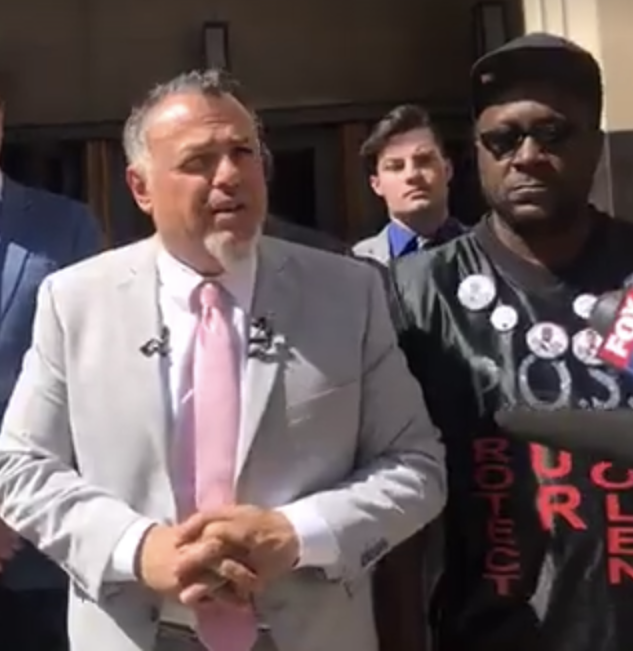
Atty. Nabih Ayad with co-counsel William Savage and Kevin Kellom at April 8 press conference.
“Defendant Fitzgerald blew the lid off this cover-up,” Ayad wrote in his response to the defendants’ motions.
“As every practicing attorney would know, it is not every day that law enforcement have the courage to come forward and speak the truth as to what transpired in a situation like this. As anyone with common sense can see, it is clear what could happen to this individual in his everyday employment with the department. E.g., isolation, stigma, harassment, hostility and possibly even violence.”
Ayad alleged that the officers on the D-FAT team and their superiors conspired to cover up the true circumstances of Terrance’s death.
The defendants claimed depositions given by family eyewitnesses were contradictory and unbelievable. Defendant Quinn said he entered the home due to “exigent circumstances,” after hearing from officers inside that the younger Kellom was “belligerent” when they attempted to arrest him. Ayad said in his brief that Quinn assumed it was OK to enter when he saw Defendant Fitzgerald inside. However, one account of what happened said that Quinn along with his parter Eaton and Fitzgerald were all outside the house prior to entry.
“Here, a defendant who is being sued for wrongful death of an individual changes his story and admits the decedent was unarmed when shot,” Ayad continued. “If Terrance Kellom was unarmed, there was excessive force used . . . All of Defendants should be thanking their lucky stars that they are not being criminally charged and put in jail at this time for conspiring to cover up the unlawful killing of an unarmed African-American young man.”
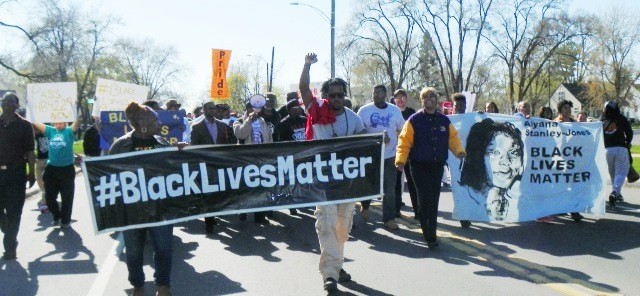
Marchers protesting Terrance Kellom’s death on April 28 2015 also remembered 7-yr. old Aiyana Jones, murdered by DPD task force in raid on home May 16, 2010
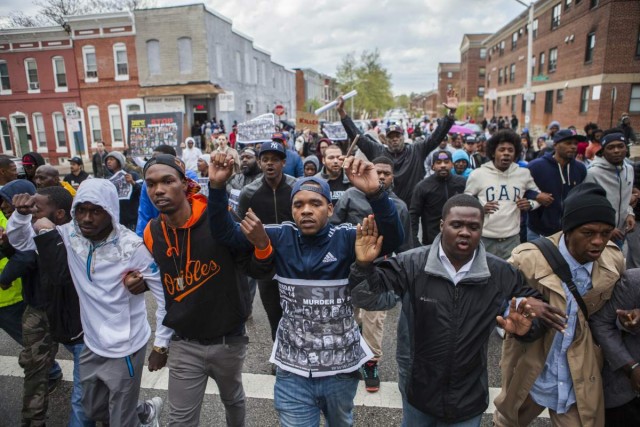
APRIL 22, 2015: Hundreds of people march through the streets of Baltimore to seek justice for the death for Freddie Gray who died from injuries suffered in Police custody in Baltimore, USA on April 22, 2015. (Photo by Samuel Corum/Anadolu Agency/Getty Images)
The D-FAT team killed Kellom as a rebellion was erupting in Baltimore over the police killing of Freddie Gray, and Black Lives Matter marches were taking place all over the country.
 Ayad additionally cited a report by Firearms Examiner and Forensic Science Consultant David Balash indicating that bullets from more than one shooter, not just Immigration and Customs Enforcement (I.C.E.) officer Mitchell Quinn, likely entered Kellom’s body from four different directions, including two from the rear which landed in his back and leg. Balash cited other forensic evidence contradicting the police version.
Ayad additionally cited a report by Firearms Examiner and Forensic Science Consultant David Balash indicating that bullets from more than one shooter, not just Immigration and Customs Enforcement (I.C.E.) officer Mitchell Quinn, likely entered Kellom’s body from four different directions, including two from the rear which landed in his back and leg. Balash cited other forensic evidence contradicting the police version.
“The investigation into the shooting death of Terrance Kellom by the Detroit Police department appears to have been driven solely by what the shooter and other members of the arrest warrant entry team told the investigators what happened rather than having the evidence drive the investigation,” Balash said.
Ayad and his partner Atty. William Savage said State Police Officer Richard Sanchez, handling his first criminal investigation, did not interview any of the officers involved. Neither did members of the Prosecutor’s office. Sanchez was situated at DPD headquarters while the investigation proceeded, and was officially embedded in the DPD homicide unit for the duration.
After Ayad’s April 8 disclosure, both Worthy and State Attorney General Dana Nessel said they would re-open their offices’ investigations into Kellom’s death. No further word from them has been heard.
Ayad said after the hearing, “If Kym Worthy doesn’t do her job this time, we will do it for her.”
The May 2 hearing itself was brief, with Judge Cox indicating that he had already thoroughly studied the filings in the case. (See box at top left for description of Plaintiffs’ Claims and Defendants’ motions.)
In addition to his First Amended Complaint, Ayad submitted a powerful brief in response to defendants’ motions. (See FAC and brief links below story.)
He attached depositions including those from Darell Fitzgerald, in which Fitzgerald denied that Terrance had a hammer and said he saw no hammer in the home, from Kevin Kellom and other family eyewitnesses who completely contradicted the police version of events, from I.C.E. agent Quinn, who alleged he could not remember how he got to the scene or what he was wearing, from state investigator Richard Sanchez, and the report from Balash. Many of the public copies of those depositions kept in the federal court for inspection were substantially redacted.

U.S. District Court Judge Sean Cox
Regarding Quinn’s motion for summary judgment, Cox said the dispute between family eyewitnesses who reported police surrounded Kellom as they walked him down the stairs from an upstairs bedroom, and police reports claiming he jumped through a hole in that bedroom’s closet to the first floor was not as relevant as “what occurred while Terrance was in the [downstairs] hallway.”
“What would you give if Terrance Kellom was not resisting, had no weapons, and had his hands up?” Cox asked the defendants. At one point, he interjected during Atty. Ayad’s arguments claiming excessive force, “You’re winning.” He also cited Kevin Kellom’s testimony in his deposition, asking if defendants were writing that off.
He asked what evidence was present that Quinn was going to shoot, and how defendants could have prevented the shooting, including obtaining a search warrant. A warrant to search the father’s home was not signed until three hours after Terrance’s death. According to depositions from family members, Teria Kellom, Terrance’s sister, had to demand to see even the arrest warrant for Terrance, which alleged he had held up a pizza delivery man.

I.C.E. agent Mitchell Quinn was previously a DPD officer with a record of brutality.
“Upon further inquiry, Officer Fitzgerald changed his story again regarding an arrest warrant, confirming that he never showed any warrant to anyone, because he was going to show the arrest warrant to Mr. Kellom only after the house was ‘clear’ but before that could happen, other officers had apparently made their way into the attic where they began shouting at Terrance Kellom,” Attorney Ayad wrote in his brief in response to Quinn’s motion for summary disposition on the case.
Ayad added that the defendants had deliberately taken a statement from a police interview with Kevin Kellom after the traumatic death of his son out of context.
“Defendant Quinn argues that Kevin Kellom consented to officer’s entering his home, and ‘supports’ this argument by quoting two partial-statements to purposefully take them out of context,” Ayad wrote.
“On the very day of his son’s killing while still emotionally shaken, Kevin Kellom was interviewed by police and stated the following in regard to the encounter he had through his screen door with officers standing on his porch:
A. And he said, “Open your door.” I said, “Open my door for what?” I said, “What’s the problem?” I said, “I didn’t call the police.” And the other guy said, Open the motherfucking door or I’m going to tear it down.” I opened the door and I let them in. I ain’t got nothing to hide from the police. I let them in . . .”
The defendants argued that there was evidence the younger Kellom lived at his father’s home, whereas Atty. Ayad said the D-FAT team went to three different addresses before going to the father’s home. He said none of Terrance’s official ID’s and other documents used his father’s address. A search warrant for the father’s home was not obtained until three hours after Terrance’s death.
In his report, forensics investigator Balash said, “Mr. Kellom suffered four (4) bullet strikes and all four are from different angles as well as directions. . . .[cites GSW’s from autopsy report]. Agent Quinn stated that Mr. Kellom charged at him and that he fired while retreating and falling with Mr. Kellom falling toward him (facedown) on the floor. The evidence and the account of the shooting do not correlate.”
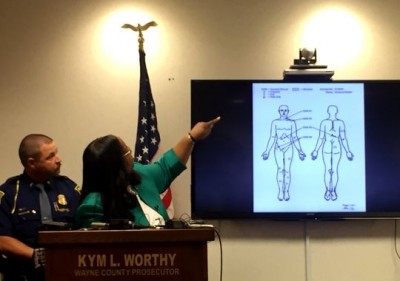
Prosecutor Kym Worthy at 2015 press conference announcing no charges in Kellom death, pointing to autopsy diagram of bullet wounds. She had sealed the autopsy report until after her findings, although autopsy reports are public record. Entrance bullet wound in Terrance’s back, which had no exit wound, is visible in diagram. Worthy explained it by saying it resulted from Terrance “turning slightly to the right” as he was shot from the front. However, further defense investigation revealed it partially exited his chest, after he was shot in the back, likely because Quinn shot him as he lay on floor.
Balash said fired cartridge casings were found in the hallway, bathroom and on one of the closet shelves. In his deposition, Kevin Kellom said he saw three officers go into the bathroom and the two rear bedrooms before his son was killed. The police version indicated only Quinn shot Kellom while standing in front of him. Fitzgerald, who was holding Terrance, said he moved to the side when Quinn began shooting.

Hallway where Terrance’s body was allegedly found by police. Black cloth covers area where gouge was found in floor, which was later determined to be a bullet hole caused by a partially exited bullet, directly under Kellom’s body.
Balash said “GSW wound #3 was located in the back of Mr. Kellom with the bullet partially exited his right chest wall . . .something prevented this bullet from fully exiting the body.” Family members Kevin and Teria Kellom reported seeing Quinn stand over their fallen loved one, possibly with his boot on his back, and shooting him in the back as he lay on the floor. Officers handcuffed Kellom after the fusillade of shots ended.
Noting the poor quality of crime scene photographs, Balash reported there was no photograph of the uncovered floor area under which Terrance allegedly laid after being shot. (Note photo to right shows area with evidence markings is covered by what appears to be a black article of clothing.)
MSP personnel had noted a gouge in the floor there. Balash said a fired bullet was recovered next to Kellom. He said the counter number #8 (seen in photo at right) was assigned to two pieces of evidence, including a bullet hole in the floor beneath Kellom’s body, which disappeared in subsequent police reports and was converted to a shell casing.
He added he did not “note any testing of the involved officer (Quinn’s) weapon for either confirmation that he was the only shooter or for the ejection pattern of his weapon. The dispersal of the fired cartridge cases at the scene should have required that testing.”
Below is a quote from the medical examiner’s autopsy regarding GSW #3:

In his answer to the Quinn motion to dismiss, Ayad additionally says that MSP Investigator Richard Sanchez could not answer questions about why the third bullet did not completely exit Kellom’s body and says eyewitnesses confirmed the circumstances:
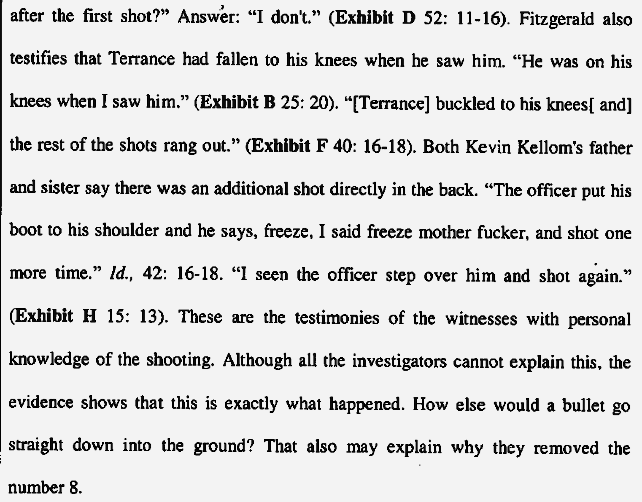
A photo of the bullet which partially exited Terrance’s back before it impacted a hard surface, likely the floor after Terrance fell face down after being shot initially, is included in Ayad’s ongoing explanation of GSW #3, taken from his continuing deposition of Investigator Sanchez.
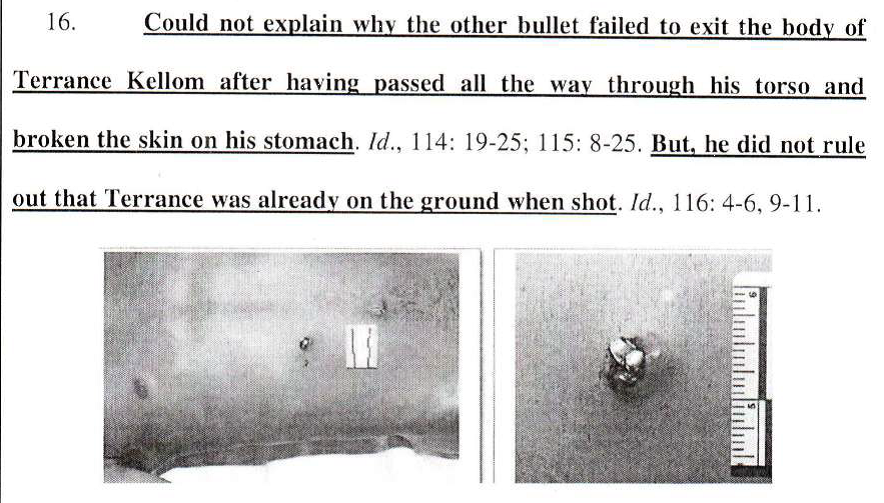
Photos of partial exit wound in Terrance’s chest, resulting from shot in back which hit hard surface. It clearly did not result from Terrance “twisting slightly to the right” as Pros. Kym Worthy conjectured. Was she deliberately covering up the evidence that this was nothing but a brutal “assassination” as Kevin Kellom called it?
After the hearing, Judge Cox said he would issue rulings on the defendants’ three motions but did not give a time frame.
Below is interview with Kevin Kellom about his son, before massive march April 28, against Terrance’s execution that took over the streets of Joy Road for hours, as Detroit police hovered nervously around, worried that it would erupt into another Baltimore rebellion.
https://youtu.be/inYHs9xbkdo
Related Documents:
TKellom First Amended Complaint, by Atty. Nabih Ayad:
http://voiceofdetroit.net/wp-content/uploads/TKellom-First-Amendend-Complaint.pdf

Terrance Kellom rest in power!
Part I and II of Atty Ayad’s response to motion for summary disposition:
http://voiceofdetroit.net/wp-content/uploads/TK-response-to-motion-for-summary-disp.-Pt.pdf
Forensic consultant David Balash report
http://voiceofdetroit.net/wp-content/uploads/Balash-Forensics-report-TKellom.pdf
RELATED STORIES:
#JailKillerKops, #Justice4TerranceKellom, #Justice4AiyanaJones, #Justice4AdaishaMiller, #Justice4KimoniDavis, #DownwithPoliceState
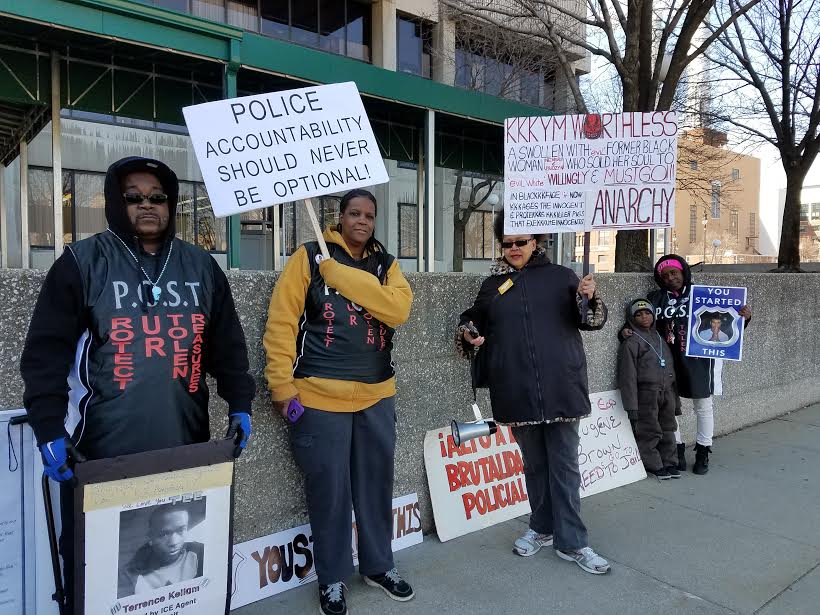
Above: Members of P.O.S.T., including Kevin Kellom at left, call for Pros. Kym Worthy to step down March 22, 2017. Kellom has never stopped fighting for his beloved son.
 Donations for the Voice of Detroit are always needed to keep this paper, which is published pro bono, going. Among ongoing expenses are quarterly Lunar Pages web host charges of $350, costs for court documents such as those used in this story, internet fees, office supplies, etc. Please, if you can:
Donations for the Voice of Detroit are always needed to keep this paper, which is published pro bono, going. Among ongoing expenses are quarterly Lunar Pages web host charges of $350, costs for court documents such as those used in this story, internet fees, office supplies, etc. Please, if you can:







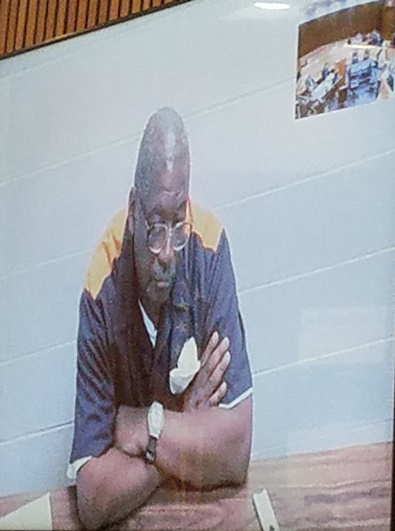
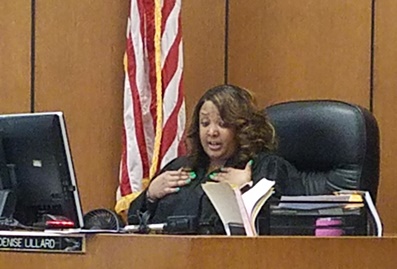
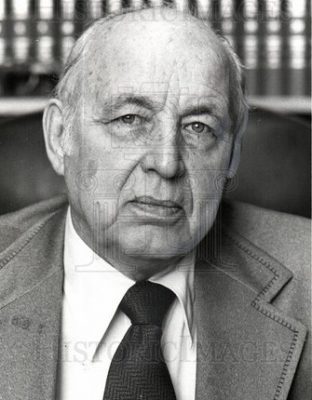

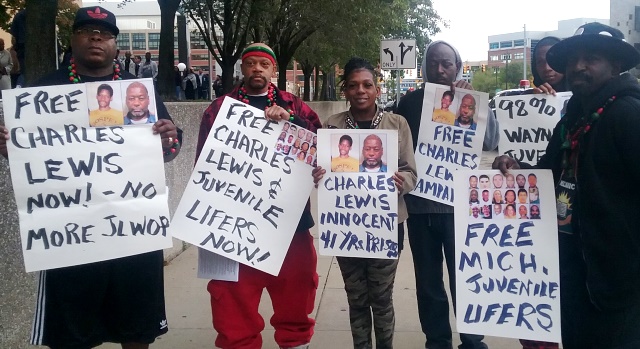
 DETROIT — Will Detroit killer cops now be sent to prison? What about lying cops, who Chief James Craig said he will fire in a newscast April 3, only to be confronted in the following days with lies told by cops in the slaughters of Terrance Kellom, 19, and Aiyana Jones, 7? Will Wayne Co. Prosecutor Kym Worthy, Chief Craig, and former U.S. Attorney Barbara McQuade face charges of collusion and obstruction of justice in the cases of Kellom, Jones, and many more?
DETROIT — Will Detroit killer cops now be sent to prison? What about lying cops, who Chief James Craig said he will fire in a newscast April 3, only to be confronted in the following days with lies told by cops in the slaughters of Terrance Kellom, 19, and Aiyana Jones, 7? Will Wayne Co. Prosecutor Kym Worthy, Chief Craig, and former U.S. Attorney Barbara McQuade face charges of collusion and obstruction of justice in the cases of Kellom, Jones, and many more? 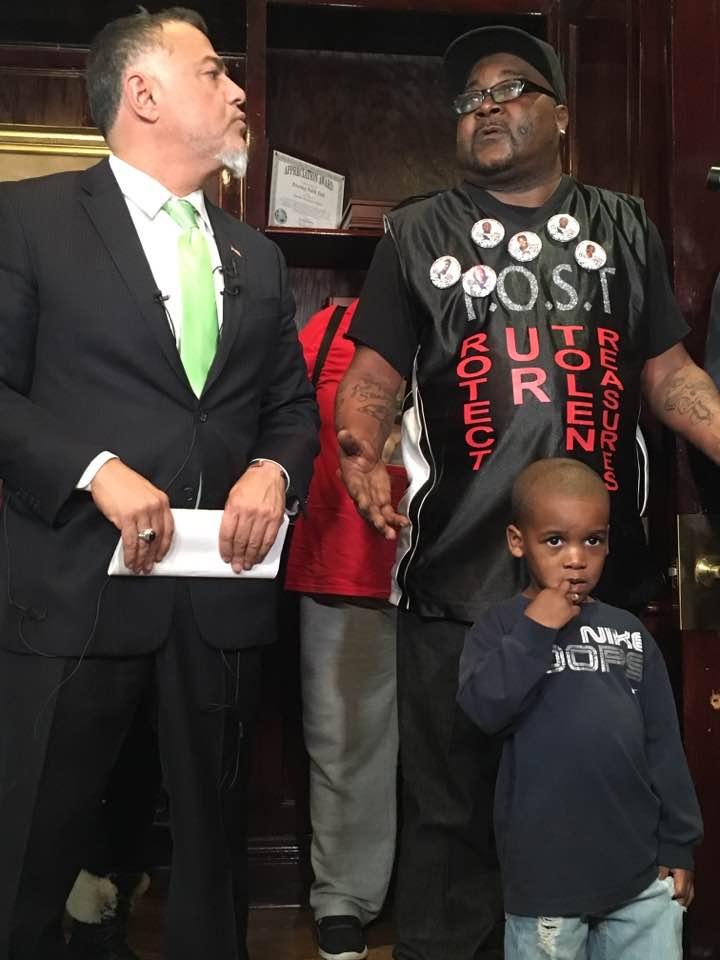



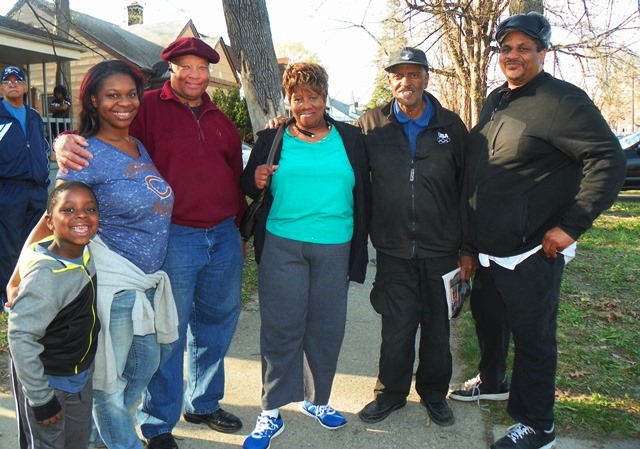



 April 3, 2019
April 3, 2019
 lections, Director of National Intelligence Dan Coats issued a report concluding that
lections, Director of National Intelligence Dan Coats issued a report concluding that 


 The complaints about “Russian election interference” made by the EU and the US, which have a long record of their own meddling in foreign nations, looks like a vivid example of pot calling kettle black, he said. The left complaining about the right receiving foreign money while receiving foreign money themselves would look similarly hypocritical.
The complaints about “Russian election interference” made by the EU and the US, which have a long record of their own meddling in foreign nations, looks like a vivid example of pot calling kettle black, he said. The left complaining about the right receiving foreign money while receiving foreign money themselves would look similarly hypocritical.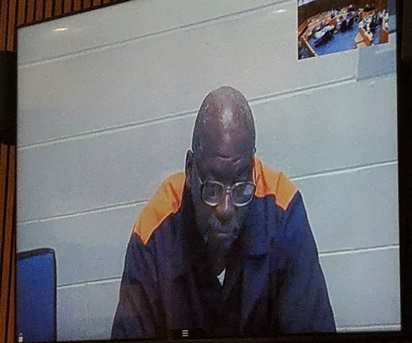
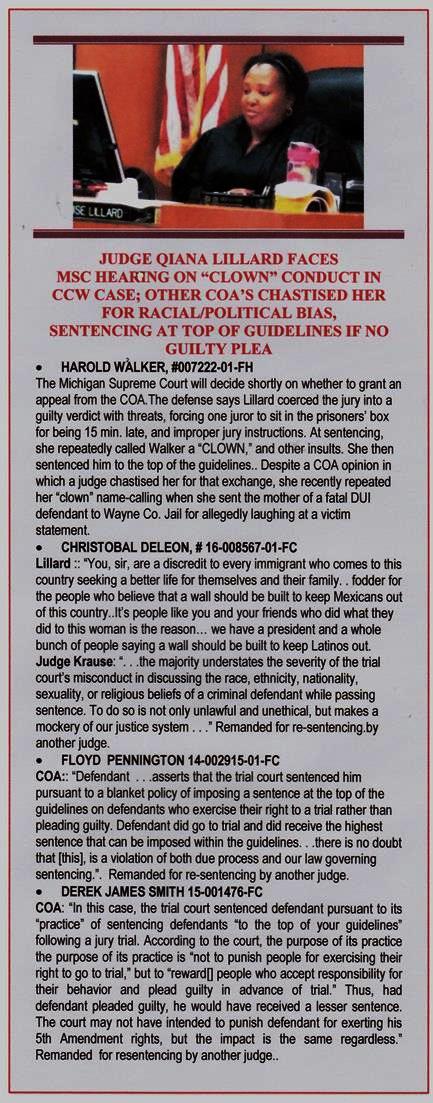 He adds however, “I have to remember in spite of how bad I may think that things are for me that they are better for me than they are for Jabo, Gray-Bey and a host of brothers here serving life that will never get out of prison. So, I’m thankful to even be in the fight for my freedom.”
He adds however, “I have to remember in spite of how bad I may think that things are for me that they are better for me than they are for Jabo, Gray-Bey and a host of brothers here serving life that will never get out of prison. So, I’m thankful to even be in the fight for my freedom.”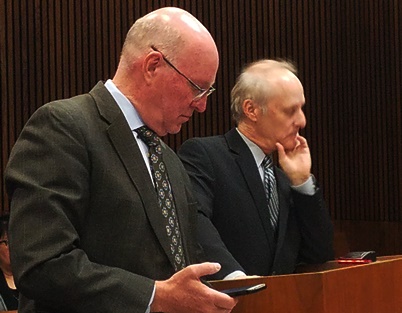




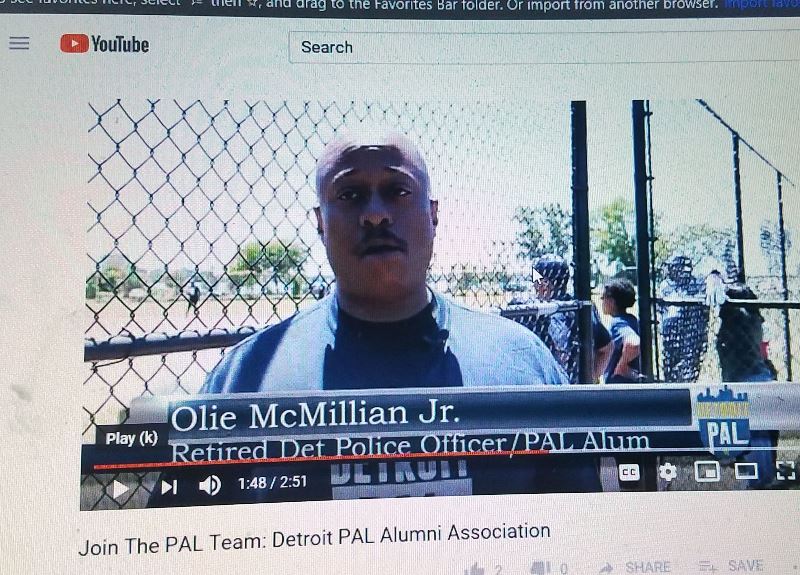
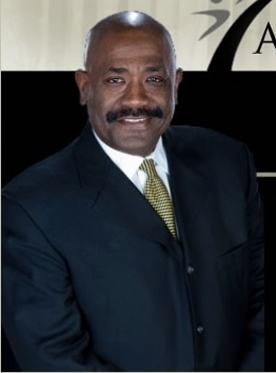
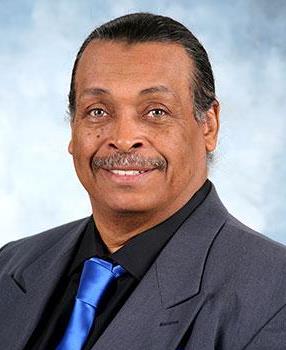

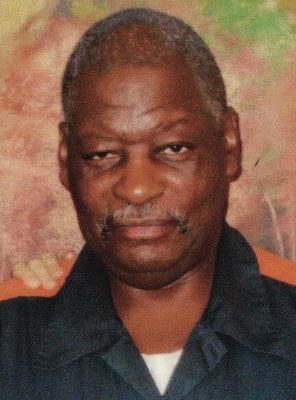

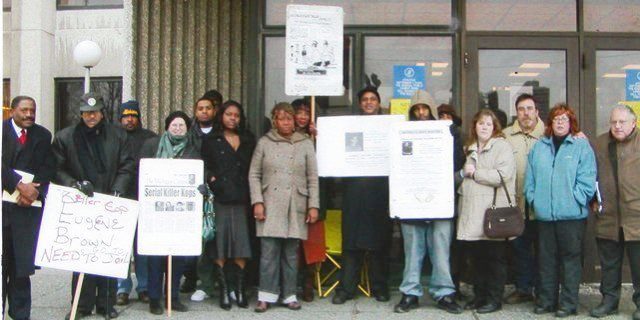
 CRAIG: DPD HAS ‘STRONG RELATIONSHIP WITH CITIZENS:”–REALLY?
CRAIG: DPD HAS ‘STRONG RELATIONSHIP WITH CITIZENS:”–REALLY?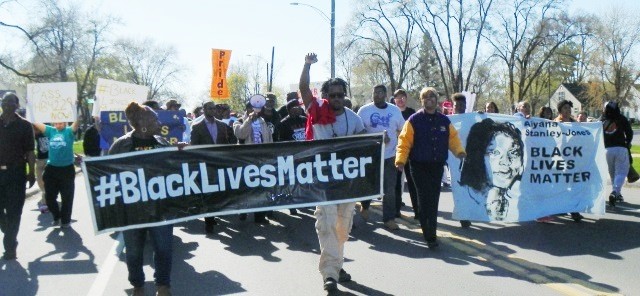 March on April 28, 2015 for Terrance Kellom, 19, killed by police April 19. Uprisings in Baltimore against the police murder of Freddie Gray were taking place at same time.
March on April 28, 2015 for Terrance Kellom, 19, killed by police April 19. Uprisings in Baltimore against the police murder of Freddie Gray were taking place at same time. TERRANCE KELLOM, 18 and a young father expecting his second child, was shot multiple times and killed after a seven-member multi-jurisdictional, multi-racial Detroit Fugitive Apprehension Task Force (D-FAT) invaded his father Kevin Kellom’s home with an armed robbery arrest warrant, but no search warrant.
TERRANCE KELLOM, 18 and a young father expecting his second child, was shot multiple times and killed after a seven-member multi-jurisdictional, multi-racial Detroit Fugitive Apprehension Task Force (D-FAT) invaded his father Kevin Kellom’s home with an armed robbery arrest warrant, but no search warrant.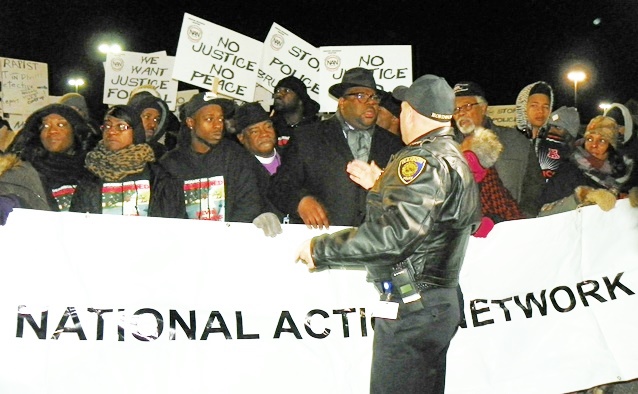







 WHAT SPARKED THE YELLOW VEST PROTESTS?
WHAT SPARKED THE YELLOW VEST PROTESTS? 
 Originally, the yellow vest protesters were people from rural areas who have to drive long distances as part of their daily life. They said they couldn’t afford the hike in fuel prices. Protests appeared in pockets around France to denounce Macron’s green tax and then quickly grew into a larger movement that includes members of the working and middle classes who are expressing their frustration about slipping standards of living.
Originally, the yellow vest protesters were people from rural areas who have to drive long distances as part of their daily life. They said they couldn’t afford the hike in fuel prices. Protests appeared in pockets around France to denounce Macron’s green tax and then quickly grew into a larger movement that includes members of the working and middle classes who are expressing their frustration about slipping standards of living. 

 Prime Minister Edouard Philippe met today with leaders of political parties holding seats in France’s Parliament to discuss possible solutions to the crisis.
Prime Minister Edouard Philippe met today with leaders of political parties holding seats in France’s Parliament to discuss possible solutions to the crisis. 


